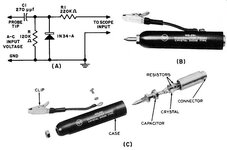neazoi
Advanced Member level 6
Hi, I have built this detector probe (RCA design) http://qrp.gr/dprobe/ to be able to align filters with a low bandwidth scope or measure transmitter power when probe/transmitter is loaded to 50 ohms.
The only change I did, was to use the 1N58A diode instead.
I want to determine, what is the maximum voltage I can put in the probe tip without damaging the diode (and hence the maximum RF power into a 50 ohms load)
The only change I did, was to use the 1N58A diode instead.
I want to determine, what is the maximum voltage I can put in the probe tip without damaging the diode (and hence the maximum RF power into a 50 ohms load)
